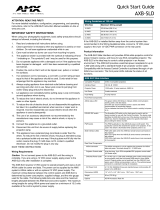
AXB-TC and AXB-TCR Television Controllers
2
AXB-TC and AXB-TCR Television Controllers (& Receivers)
Specifications
The following table list the product specifications for the television controllers. Other than the IR Input
Window (on the AXB-TCR only), the specifications for the TC and TCR are identical.
AXB-TC/TCR Specifications
Dimensions (HWD):
(with connectors) • 1.29" x 3.33" x 5.54" (32.8 mm x 84.6 mm x 140.6 mm)
Power consumption: 200 mA @ 12 VDC
Front Panel Components:
LED indicators • AXlink LED (green and blinks to indicate AXlink communication activity
and power:
• Full-Off indicates no power is being received or the controller is not
functioning properly.
• One blink per second indicates power is active and AXlink
communication is functioning.
• Full-On indicates there is no AXlink control or activity, but power is On.
IR Out: Red LED blinks when the television controller transmits IR or
serial (outgoing) signals.
One blink every 2 seconds: The AXB-TC/TCR program is not loaded.
TV Sensor: Red LED that lights when the television controller receives,
via the CC-IR TV Sensor, the correct horizontal scan frequency signal
indicating television or monitor power is on.
This LED also lights when the television controller receives a power on
status from an AMX PCS Power Control Sensor.
One blink every 2 seconds: The AXB-TC/TCR program is not loaded
DEVICE DIP switch 8-position DIP switch that sets the AXlink device number on the AXB-TC
and AXB-TCR.
IR Input Window (AXB-TCR only) Receives 38 kHz IR-control signals from AMX transmitters.
The IR input window contains a red LED that lights when receiving IR-
control data.
IR Compatibility (AXB-TCR only) AMX wireless IR control panels and hand-held transmitters (38 kHz only)
Rear Panel components:
TV Sensor connector 2-pin (male) connector that supports horizontal scan frequency sensing
up to 65 kHz with a CC-IR TV Sensor. The connector can also be used
with a PCS (Power Current Sensor) to detect television power status (on
or off).
TV Sensor POT Sets the sensitivity to the PCS. You may need to adjust this POT to allow
the PCS to detect the television's power status (on or off).
IR Emitter connector 2-pin (male) connector that transmits IR control signals to a television
using the CC-IRC IR Emitter cables. The connector also supports trans-
mitting serial control data to an external device.
AXlink connector 4-pin (male) connector that supports AXlink control data communication.
PWR connector 2-pin (male) connector that connects to an external 12 VDC power sup-
ply. Refer to theWiring section on page 7 for external power supply
requirements.
Enclosure: Plastic with black matte finish
Weight: 6 oz. (170 grams)





















